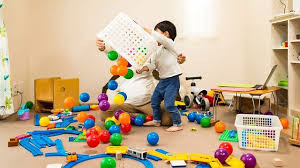
to
Where I grew up, kindergarten was half-day and I attended the afternoon session. I walked to school with a friend most of the time, but sometimes I walked alone. I clearly remember one of those alone days. It was warm, so it was probably towards the end of the school year. The neighborhood was quiet and peaceful. When I got to the school-yard, however, my route, which required walking through a large field of grass, was disrupted. Multiple sprinklers were on, watering the grass with large, overlapping arcs, while making that all-too-familiar tch-tch-tch sound. I knew I wasn't going to get to the other side of those sprinklers without getting soaked.
I considered my options. Here was what my little six-year-old brain came up with: I could run through the sprinklers and get to school dripping wet, but on time. Or I could backtrack and take the long way to school, through the otherside of the neighborhood. It would get me to class dry, but I would be late. I choose the latter. When my teacher asked me why I was late, I simply told her that the sprinklers were on in the field and I had to take the long way to school. She said she understood and that was that.
Not to toot my own horn, but I really like my six-year-old self. She was confident, pragmatic, and competent. Not once did she consider going home to ask Mom for help or a ride to school. She didn't panic. She wasn't stressed or overwhelmed. She just considered the situation, as well as the solutions, chose one and moved on.
When considering my childhood, this is probably the best example I can provide that illustrates, in a fair and honest way, what being a Gen X kid was like. Yes, we roamed the neighborhood until dark, engaged in play that, these days, many consider too risky, and we were often home alone, but we were highly capable for our age.
In the world of parenting, hindsight often shapes current practices. As modern parents, we frequently analyze the upbringing styles of previous generations to craft what we believe to be better environments for our children. One such critique has been leveled at the Generation X experience—those of us who grew up in the 1970s and 1980s. Often labeled as "latchkey kids," we enjoyed significant physical independence, which has often been misconstrued as a sign of neglect. This has spurred a cultural shift towards over-parenting that has lead to over-scheduled lives and little free time for today's children. So, as we critique past generations, it's crucial we understand the nuanced realities of past and present childhoods and distinguish between different types of childhood independence.
It's tempting to label the free-range approach of the 70's and 80's as neglectful, unsafe, or unwise. For many modern-day parents, doing so supports their over-involved, anxious approach. In actuality, that free-range approach cultivated development in the best ways. We know that childhood independence and free-play foster problem-solving skills, social skills, resilience, and self-reliance, to name a few. Nevertheless, despite all of this good, there was something missing for many Gen X kids - parental emotional availability.
The parents of Generation X were characterized by a 'silent strength' that prioritized survival and practicality over emotional expression. Societal norms at the time valued stoicism and self-reliance, leading to a legacy of emotional unavailability. Emotional availability wasn't a concern parents in the 70's and 80's were highly conscious of; instead, survival and providing materially were paramount.
In most cases, this was not due to neglect, but rather as a consequence of their parents’ upbringing. Keep in mind, members of this previous generation were raised by parents who lived through significant societal upheaval—marked by the Great Depression and two World Wars. These significant and extremely challenging events shaped their worldviews, making them practical, but emotionally reserved parents. Additionally, economic challenges, such as the oil crises and recessions throughout the 1970s, necessitated a significant increase in dual-income households, without a reliable day-care structure for parents to rely on.
So how have modern-day parents compensated for the lack of parental emotional availability in their own childhoods? More often than not, parents today have swung the pendulum too far in the opposite direction. And by doing so, these parents aren't any more emotionally available to their own kids, than their parents were to them. Over-scheduling a child's life and utilizing overprotective scrutiny and micromanaging every aspect of a child's emotional landscape is not parental emotional availability. Being emotionally available doesn't mean shielding a child from every possible adversity. It's not about removing every hurdle or challenge, while calmly talking to them about emotions. Parental emotional availability is not sparing a child from life's disappointments or creating a bubble-wrapped, activity-filled world for them.
Parental emotional availability is about fostering a relational atmosphere that lets a child know that they can come to their parent for support and guidance. It is being present. responsive, and empathetic in small ways throughout the day. It's about taking a moment to stop what you're doing, make eye contact with your child, and just listen and guide. It's not about ensuring you are present for every emotional moment, while talking deeply about emotions. It's about creating a safe haven in which your kid feels comfortable coming to you with their worries and concerns. It's about allowing your child to experience challenges and hardship. This is what fosters emotional independence in children.
For parents today, striking a balance between physical independence and emotional independence can be challenging. Parents experience immense pressure to keep up with everyone else. In the long run, the childhood rate-race is harming our children. But striking this important balance is possible. It's about slowing down and doing less. It's about encouraging free-play and independence without much adult supervision. It's about giving children the space to explore while being a reliable source of comfort and guidance. It's about encouraging dialogue and emotional expression, while letting our kids struggle and work through their hardships.
As we navigate the intricacies of modern parenting, let's appreciate the lessons from past generations without mislabeling their methods. We can learn so much from the free-range upbringing of Generation X, while also recognizing that today's parenting landscape permits new approaches. There are promising trends regarding parents' emotional engagement these days. As awareness grows about mental health and emotional well-being, many parents today actively seek to build healthy emotional connections with their children. We can, and we should, combine emotional availability with independence, crafting a nurturing yet empowering environment for our children. This delicate equilibrium supports their development in the most effective way, thus preparing them for the journey of adulthood.
**References:**
- Autor, D. H., & Dorn, D. (2013). *The Growth of Low Skill Service Jobs and the Polarization of the US Labor Market*. American Economic Review.
- Brussoni, M., Olsen, L. L., Pike, I., & Sleet, D. A. (2015). *Risky play and children's safety: Balancing priorities for optimal child development*. International Journal of Environmental Research and Public Health.
- Fraley, R. C., Roisman, G. I., & Haltigan, J. D. (2013). *The legacy of early experiences in development: Formalizing alternative models of how early experiences are carried forward over time*. Child Development.

Here's a scenario: a couple is in therapy and spouse one is sharing feelings of frustration, resentment, and exhaustion due to having too much on their plate. They explain that they get little or no help from their partner with the day to day management of the kids and the home. Their experience is that their spouse rarely, or even never, thinks about, plans, or implements the day to day tasks required to run a household.
At its core, mental load refers to the cognitive effort and planning required to manage household tasks and responsibilities. It includes the management, organization, and anticipation of needs within the household. It's the invisible work that goes into remembering to buy groceries, scheduling doctor’s appointments, plan meals, or ensure that school forms are completed on time. It also includes things like the management of home maintenance, home repairs, or ensuring bills are paid on time,
In my work with couples, I have certainly encountered cases in which there exists a true imbalance in mental load, as well as physical load for that matter. When this is the case, it is often a complicated situation, requiring thoughtful care. More often than not, however, when a spouse or partner expresses their frustration about carrying too much of the mental load, that spouse is actually contributing to the imbalance.
And here's why. Most people have learned about mental load through social media. Social media paints the concept of mental load as extremely simple, with little nuance. In reality, it's a complicated issue. When it comes up in therapy, it requires careful assessment. Here are the main things I'm curious about when working with a couple in regards to mental load:
- Are either of them prone to anxiety? If so, when do symptoms arise? A person experiencing anxiety might prioritize a task that their partner never worries about. The task may not be that important actually, but it feels important to one (because of anxiety) and not the other. Or it may be an important task, but it causes anxiety in one (or both) so it's avoided.
- How is task tolerance showing up? When it comes to task completion, does one prefer to complete the task as soon as possible, while the other tends to wait until the last minute? This dynamic can often cause an ineffective relational cycle in which one spouse or partner is never given the chance to complete the task because the other has difficulty tolerating their timing.
- Is perfectionism or attempts at control at play? Are expectations for task management realistic? Is one spouse often critical of how the other handles things? Or do they have little tolerance for mistakes made by their partner? This dynamic creates task avoidance. Why try if you'll never do it right in their eyes anyway? Often times, the spouse is actually showing up in an equitable way, but the other spouse is placing blame to avoid their own discomforts.
- What does work look like for the couple? Who's working in the home, out of the home? How many hours? How does the family interact when everyone is home? Do either or both travel for work, work night shifts, etc.?
When an individual misunderstands what true mental load looks like, he or she might inadvertently use the concept of mental load as leverage in the relationship. Instead of fostering an environment of cooperation and mutual respect, a cycle of blame and avoidance is created, leaving the true relational issues unresolved.
So, yes, on one side of the coin there exists a true imbalance of the mental load and one partner or spouse is paying a heavy price. But on the other side of that coin, is a poor replica. It may appear to be an imbalance, but when looked at closely, it just isn't the real thing. A true imbalance cannot exist when both are contributing to its cause.
By recognizing and addressing the deeper issues—anxiety, control needs, or different levels of tolerance—couples can collaboratively find solutions that allow both individuals to feel heard, understood, and valued. Engaging in discussions without pointing fingers fosters a healthy partnership where mental load becomes a shared, rather than isolated, experience.
While mental load is an essential concept for identifying unseen labor in relationships, it should never be an excuse to ignore underlying personal challenges, or used to control power dynamics within the relationship. Understanding and properly addressing mental load can lead to deeper connection and understanding, allowing relationships to flourish in a healthy, balanced, and equitable way.
*Remember, when learning about mental health on social media, check your source and do your own research. Just because it's posted, doesn't mean it's an accurate or complete explanation, even if it's well-intentioned.

In the bustling world of parenting, maintaining a tranquil atmosphere is no small feat. With daily life often filled with a flurry of activity, emotional outbursts and challenging behaviors are bound to happen, both from children and parents. It's during these instances that the significance of timeouts and understanding the power of pausing comes into play. Timeouts, when used appropriately, offer windows of calm to foster emotional development and learning, while also enriching the relational health between child and parent. Here are some benefits of implementing emotional pauses or timeouts:
1. Emotional Regulation: Timeouts provide a structured environment for kids and teenagers to learn to manage their emotions. When feeling overwhelmed by frustration or anger, a brief pause can help your child regain composure and reflect on their feelings. Over time, this practice reinforces self-regulation skills that are crucial for emotional development.
2. Reflective Learning: A well-timed pause offers children a chance to think about their actions and the subsequent consequences. This reflection time is critical in helping them understand right from wrong, thereby nurturing their moral development.
3. Parental Calmness: Timeouts aren’t just beneficial for children. They also offer parents a moment to gather their thoughts and approach the situation calmly and with a clear head. This ensures that parents respond thoughtfully rather than react impulsively, fostering a more harmonious relationship.
What Does An Effective Timeout Look Like?
1. Consistency is Key: Use timeouts consistently as a response to specific behaviors, such as tantrums or unkindness during peer-to-peer play. This predictability helps children understand the boundaries and reinforces the learning process.
2. Provide a Warning; Saying something like, "Please stop throwing the blocks or you'll need to take a break." allows the child time to adjust their behavior or pivot if a pause is needed. Utilizing a timeout in an effort to redirect behavior doesn't need to be long. Thirty seconds to one minute for young children is usually effective.
3. Create a Calm Space: Designate a quiet and safe timeout area. This should not feel like a punishment zone but rather a peaceful place where your child can calm down and reflect.
4. Check-in: Utilizing empathy and checking in with your child while they're in a pause, will reinforce feelings of security and love in your child.
5. Reconnect Post-Timeout: Once the timeout is over, take the opportunity to discuss the behavior calmly. Ask your child how they felt and explain the reason behind the timeout. This helps in reaffirming lessons and strengthens your emotional bond.
What Makes a Timeout or Pause Ineffective?
1. Angry Pauses: Implementing a timeout out of anger can have a detrimental effect. It’s important to differentiate a calm pause from a punitive one. If a timeout is given in the heat of the moment, it may convey rejection rather than guidance, causing the child to feel alienated and shamed.
2. Isolation: Timeouts should never be about isolating the child. Instead, they should be considered a pause for calming down, redirecting behavior, or reflection (reflection will depend on the child's age and developmental level). Ensure that the timeout spot is within a comfortable and close proximity to avoid feelings of abandonment. When redirecting behavior in young children, it can be helpful to remove the child for a moment and discuss the situation with them in a simple, age-appropriate way.
3. Negative Labels and Comments: Avoid using phrases like "bad boy" or "bad girl" while giving a timeout. This can damage your child’s self-esteem. Focus on addressing the behavior, not labeling the child.
4. Don't Prolong the Pause or Give It a Specific Time Limit: The pause is about emotional regulation and/or behavioral redirection, as well as ensuring the child has the time and space for development to do its job.
Angry pauses, or timeouts used as arbitrary punishment, can have lasting negative effects on a child's emotional well-being and the overall dynamics between parent and child. When timeouts are given in anger, they often become punitive rather than educational and developmental. This can make the child feel shamed and misunderstood, potentially leading to increased behavioral issues and strained relationships. Furthermore, it may teach children to associate conflict resolution with avoidance rather than understanding and communication.
On the other hand, implementing timeouts thoughtfully can transform big emotional moments into powerful tools for emotional growth and relational harmony. They serve as essential pauses that allow children to process emotions and allow parents to approach situations with calmness and clarity. By applying the principles of consistent, calm, and compassionate timeouts, you foster a nurturing environment where emotional development thrives, and the parent-child bond is strengthened. Remember, every emotional moment is an opportunity to connect, guide, and grow together.
I'd love to hear your experiences and thoughts on using timeouts. Share your stories in the comments below!

It's a heavy, uncomfortable feeling, that moment when we realize we've made a mistake. In that moment, we have choices. We can choose to over-engage with that experience and step into shame-based thinking and avoidance, or we can apologize, Yes, it's usually as simple as that. Utilizing an authentic apology is not only a necessary and effective relational tool, it's also a useful form of self care.
As parents, we often strive to be "perfect" role models for our children. Yet, just like everyone else, we’re not immune to making mistakes. Whether your children are still at home or have grown into adults, one of the most powerful ways you can demonstrate love and respect is by acknowledging your errors and making amends. Apologizing and attempting to repair relationships is not just beneficial—it’s essential, and it's never too late to start.
Why Apologizing Matters
1. Modeling Accountability: Apologizing to your children, regardless of their age, teaches them the importance of taking responsibility for their actions. This lesson is crucial for both their personal and relational development.
2. Building Trust: Honesty and vulnerability engender trust. When you apologize sincerely, you show your children that you value the relationship enough to own up to your mistakes.
3. Emotional Healing: Apologizing can be profoundly healing for both you and your child. It allows wounds—whether recent or decades old—to begin to heal, fostering a healthier emotional landscape for everyone involved.
Tips for Apologizing to Younger Children:
1. Get Down to Their Level: Physically lowering yourself to eye level can make the apology more sincere and direct.
2. Use Simple Language: Kids respond better to straightforward, age-appropriate language. Avoid complicating the apology with too many details.
3. Acknowledge Their Feelings: Saying something like, "I understand that when I raised my voice, it scared you. I'm really sorry," helps them feel seen and heard.
4. Allow the Apology to Stand Alone: Avoid redirection or pointing out what the child did that contributed to your frustration. Make sure the child always knows your emotions are not their fault or responsibility.
Tips for Apologizing to Adult Children:
1. Be Sincere and Specific: A heartfelt apology should clearly state what you’re apologizing for. Avoid vague statements like, “I’m sorry for everything.”
2. Validate Their Experience: Acknowledge their feelings and experiences without being defensive. For instance, "I didn't fully understand how my actions affected you, and I deeply regret it."
3. Focus on Repair and Growth: Offer actionable steps to repair the relationship and demonstrate a commitment to change. This could be through regular communication, therapy, or simply making an effort to be more supportive.
4. Accept Your Adult Child's Response: Apologizing is you taking responsibility for you. It's not a guarantee that your relationship will improve.
Studies in adult development, such as those by renowned psychologist Erik Erikson, highlight the importance of reflecting on past actions in later stages of life. Erikson's theory suggests that meaningful relationships and generativity—making amends and leaving a positive legacy—are vital components of a fulfilling life. Apologizing is a powerful way to foster these elements in your relationship with your children, regardless of their age.
Dr. Robert Kegan’s work on adult development also emphasizes the concept of evolving self-identity. Apologizing and repairing relationships can be a transformative experience that contributes to both emotional and cognitive development.
By openly embracing the power of an apology, you create a legacy rooted in love, humility, and growth. It's never too late to apologize and make amends. Whether it’s a heartfelt conversation over coffee with your adult child or a gentle word with your little one before bed, the act of apologizing can significantly strengthen your relationship, as well as your positive sense of self.
What have you found most challenging about apologizing? Share your thoughts in the comments below!

In today’s fast-paced digital world, discussions about childhood safety often ignite strong emotions among parents and caregivers. In 2008, journalist Lenora Skenazy wrote a column in the New York Times about allowing her 9 year-old-son to ride the subway alone. The article caused an uproar in many parenting communities and Lenora was dubbed 'America's Worst Mom'. Today, Lenora is the president of the organization, Let Grow, which advocates for the importance of childhood independence and free-range parenting.
With examples like this, it's easy to see how pervasive the misunderstandings regarding childhood safety are. The 24/7 news cycle and increased social media coverage of tragic events aren't helping. Parents are often surprised when I tell them their kids are safer today than in past generations. Let's look at what the numbers say:
1. Child Mortality Rates: According to the Centers for Disease Control and Prevention (CDC), the overall child mortality rate in the United States has significantly decreased over the past few decades. In 1980, the child mortality rate for children aged 1-4 was 64 per 100,000. By 2019, this rate had dropped to 26 per 100,000.
2. Abduction and Stranger Danger: The National Center for Missing and Exploited Children reports that abductions by strangers are exceedingly rare. Data indicates that in recent years, only about 100 cases a year were classified as "stereotypical kidnappings" out of hundreds of thousands of missing children's reports annually. Most missing children are actually runaways or abducted by someone they know, such as a non-custodial parent. Misunderstandings, like a child going to a friend's house without the parent knowing, can also result in a 'missing child' statistic.
3. Injury and Accident Rates: Advances in car safety, childproofing homes, and better medical care have significantly reduced the risk of serious injuries or fatalities among children. For example, the usage of car seats has drastically increased, contributing to a nearly 60% reduction in motor vehicle deaths among children under the age of four from 1999 to 2019.
Why the Perception of Danger Persists
Despite the data suggesting improved safety, the perception that children are less safe today is strongly ingrained. There are several reasons for this:
1. Media Coverage: The widespread availability of news and social media amplifies the visibility of rare but tragic events, leading to a heightened sense of danger. It's important to remember that while these stories are shocking and heart-wrenching, they are not representative of typical risks faced by children daily.
2. Parental Anxiety: Understandably, parents want to protect their children from any harm, and the thought of potential dangers can be overwhelming. As a result, even small risks may be perceived as significant threats.
3. Nostalgia and Selective Memory: Many people look back on their childhoods through rose-tinted glasses, remembering the freedom and seemingly lower levels of supervision due to it being a "safer time'" However, historical data often shows that children in the past faced different, and sometimes greater, risks than they do today.
So where do we go from here? While understanding that children are statistically safer today can provide some reassurance, it doesn’t negate the need for vigilance and proactive safety measures. Here are some practical steps parents can take to balance awareness with action:
1. Educate Yourself and Your Children: Stay informed about current safety recommendations from reputable organizations. Educate your children about personal safety without instilling unnecessary fear.
2. Empower Rather than Overprotect: Encourage age-appropriate independence and problem-solving skills. Teach children how to recognize and respond to unsafe situations, whether online or in real life. Teaching a child how to effectively use assertiveness, such as recognizing who they can go to for assistance when in public, or what to say no to and how to say it, is much more valuable to their development and overall safety than 'sheltering in place'.
3. Focus on Practical Safety Measures: Implement practical safety measures in your daily life, such as using appropriate car seats, ensuring home safety with smoke detectors, and discussing internet safety with older children. Remember, age-appropriate danger, such as climbing a tree or balancing on a log, are hugely beneficial to the developmental process.
Understanding childhood safety requires us to look beyond sensational headlines and focus on the facts. While it's natural to be concerned for our children's well-being, it's equally important to recognize the progress made in protecting them. By informing ourselves with accurate data and implementing practical safety measures, we can ensure our children grow up in a safe and nurturing environment, free from unnecessary fear. Let's celebrate the strides we've made and continue to prioritize balanced, informed approaches to childhood safety.







